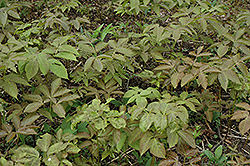It's all about ...
plants

Height: 24 inches
Spread: 24 inches
Sunlight:
![]()
![]()
Hardiness Zone: 3a
Other Names: False Sarsaparilla, Shot Bush
Description:
Attractive native perennial used in the garden mostly for its foliage; 3 leaflets on long stalks can be mistaken for poison ivy; berries taste spicy and sweet; plant parts have historic medicinal value
Ornamental Features
Wild Sarsaparilla's attractive serrated oval compound leaves emerge coppery-bronze in spring, turning emerald green in colour on a plant with an upright spreading habit of growth. As an added bonus, the foliage turns a gorgeous orange in the fall. It features subtle nodding white ball-shaped flowers at the ends of the stems in early summer. It produces deep purple berries from late summer to early fall.
Landscape Attributes
Wild Sarsaparilla is an open herbaceous perennial with an upright spreading habit of growth. Its medium texture blends into the garden, but can always be balanced by a couple of finer or coarser plants for an effective composition.
This is a high maintenance plant that will require regular care and upkeep, and is best cleaned up in early spring before it resumes active growth for the season. Gardeners should be aware of the following characteristic(s) that may warrant special consideration;
- Suckering
Wild Sarsaparilla is recommended for the following landscape applications;
- Mass Planting
- Border Edging
- General Garden Use
- Groundcover
- Naturalizing And Woodland Gardens
Planting & Growing
Wild Sarsaparilla will grow to be about 24 inches tall at maturity, with a spread of 24 inches. It grows at a medium rate, and under ideal conditions can be expected to live for approximately 10 years. As an herbaceous perennial, this plant will usually die back to the crown each winter, and will regrow from the base each spring. Be careful not to disturb the crown in late winter when it may not be readily seen!
This plant does best in full sun to partial shade. It prefers to grow in average to moist conditions, and shouldn't be allowed to dry out. It is not particular as to soil type or pH. It is somewhat tolerant of urban pollution. This species is native to parts of North America. It can be propagated by division.
